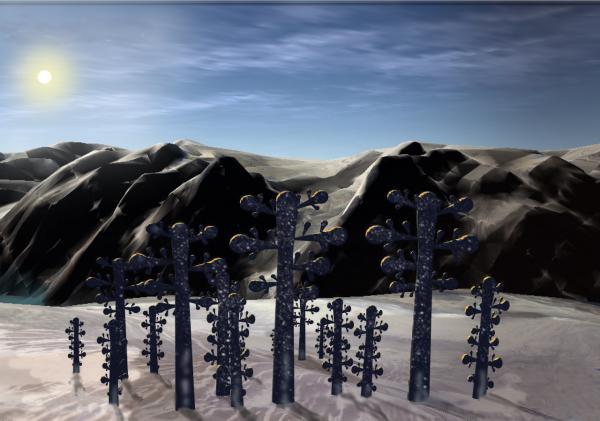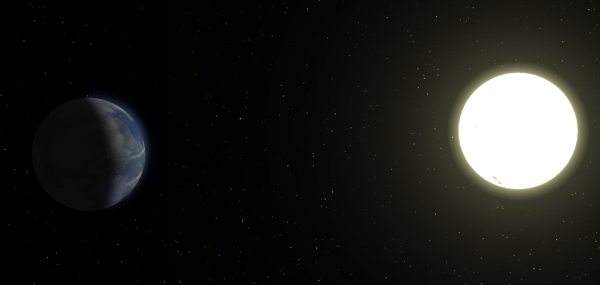BY LETTER
Orobon
Galactography > Regions of Space > Middle Regions/Hinter-regions
Galactography > Systems and Worlds > Systems & Worlds O - P
Galactography > Systems and Worlds > Systems & Worlds O - P
Xenoterraformed world orbiting a white dwarf | |
 Image from Steve Bowers | |
| A spoontree forest near the north polar frostline, showing how trees on this world orient themselves towards the tiny white dwarf star, which hangs motionless in the sky. | |
Star
Name: JD 4409090, Tyrion.
Distance from Sol: 214 ly.
Constellation: Puppis - in the so-called Garden of Paradise Cluster.
Class: white dwarf.
Luminosity: 0.00013 x Sol
Temperature: 5700 K
Mass 0.5 x Sol
Radius 7932 km
Planet
Name: Orobon
Type: Tidally locked Vesperian world terraformed by the vanished alien species known as the Mysterians.
Semimajor Axis: 0.01140 AU (1,705,415 km)
Orbital Period: 0.628 days
Mass: 1.4 X Earth
Radius: 1.1041 X Earth (7043 km)
Gravity: 1.15 gees
Colonised: 2877 AT
Orobon is a xenoterraformed world in the Paradise Cluster, in orbit around the cool white dwarf star known as Tyrion.
This is an unusual example of a life-bearing world orbiting a white dwarf; this world was terraformed by the alien species known by Terragens as the Mysterians (a species classified by the Hamiltonian Institute as HIE014CZE). Orobon was probably a dry world considerably further away from the star, formed from a depleted gas giant left behind after the star left the main sequence nearly four billion years ago. Approximately 39 million years ago the Mysterians moved this planet inwards into the white dwarf's habitable zone, and introduced a specialised version of their biota onto the tidally locked planet.
Despite being tidally-locked, Orobon has a rotation period of fifteen hours with respect to the rest of the galaxy, and high winds near the equator cause significant atmospheric heat transfer from the sunward side to the night side. Wind speeds are lower near the poles, and forests of fibrous spoontrees grow there. In the warmer zones of the dark side, saphrophytes feed on organic materials blown from the dayside. Orobon is gradually getting cooler, as the star loses heat over time; unlike Main Sequence stars, which get warmer over time as they get denser, white dwarfs get cooler. In less than a billion years Orobon will become an iceball.
 Image from Steve Bowers | |
| Orobon compared in size to its local star, a cool white dwarf only a little larger than the planet | |
The Sophic League colonists who inhabit this system rarely visit the planet's surface in person, but dwell in habitats built in the debris ring that lies outside the planet's orbit. This debris ring mostly consists of the remnants of the apparatus used by the Mysterians to move Orobon into the habitable zone; a population of spiritual vecs and aioids has become established here. Many of these sophont machines are members of the Church of the Great Programmer, a popular aioid religion in the League.
In addition several groups of biont colonists have inhabited the debris ring at various times over the last seven millennia, perhaps most notably the near-baseline humans of the notorious Huxlyite sect. The Huxlyites believed that a biont's soul could best be saved by a life of extreme hedonism, and for more than a thousand years in the ComEmp period and afterwards the Orobon Ring was a famous (and infamous) centre for debauchery and induced bliss of myriad kinds.
By the Age of Re-Evaluation a backlash against this so-called 'binge culture' became ascendant in the system, and a new strict code of morality and sobriety took over. By the Outer Volumes Era society in the Debris Ring had changed once again, into a more cosmopolitan mix, but one which is periodically marked by the revival of various updated forms of Huxlyism, or the occasional bout of social abstemiousness.
Throughout this period the Hamiltonian Institute has maintained a presence in the Ring, attempting to piece together the minute fragments of Mysterian technology that remain in this system.
Related Articles
Appears in Topics
Development Notes
Text by Steve Bowers
Initially published on 10 June 2015.
Initially published on 10 June 2015.






